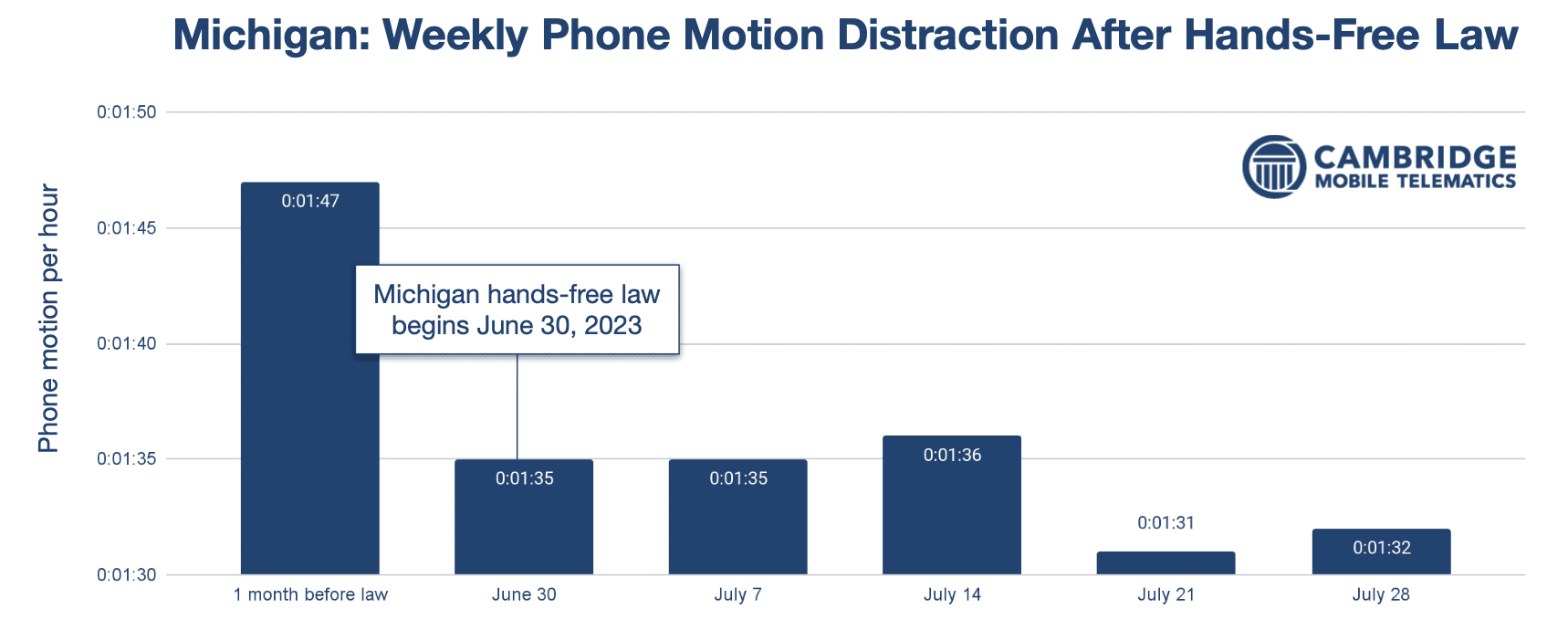Michigan Hands-Free Law Has Prevented 650 Crashes & Two Fatalities
New data from Cambridge Mobile Telematics shows an 11.2% drop in phone motion distraction since June 30, 2023

Cambridge, MA, August 1, 2023 — Cambridge Mobile Telematics (CMT), the world’s largest telematics service provider, today announced an analysis of the impact of the new hands-free law in Michigan, which began June 30, 2023. The analysis shows that Michigan drivers spent an average of 1 minute and 47 seconds per hour on the road handling their phones in June. Since the start of the hands-free law, phone motion distraction has fallen to an average of 1 minute and 35 seconds per hour, a drop of 11.2%.
CMT’s data shows that every 10% decrease in distracted driving reduces the crash rate by 1.4%. CMT estimates that the 11.2% reduction in distraction in Michigan since June 30 has helped prevent 650 crashes, two fatalities, and $15.5 million in economic damages.*
“We are extremely encouraged by the initial results of Michigan’s hands-free legislation,” said Steve Kiefer, Chairman of The Kiefer Foundation and Chairperson of CMT’s Road Safety Board. “These life-saving laws are especially critical during the 100 Deadliest Days of Summer when crashes and fatalities typically increase by 15%. We hope the recent results from Michigan and Ohio inspire the remaining 21 states to enact similar legislation that reduces distracted driving, prevents crashes, and saves lives.”
In addition to Michigan, CMT has measured the impact of hands-free legislation across Ohio and Alabama since April 2023. Ohio has seen a sustained reduction in distracted driving of 10% since its law began in early April. Alabama, which introduced its law on June 16, experienced a 2.4% reduction before returning to pre-law levels after just one month. Both Michigan and Ohio made distracted driving a primary offense. Alabama’s law made distraction a secondary offense, where a police officer can’t ticket a driver for distracted driving unless they commit a primary offense, like speeding.
“The results from Michigan and Ohio show the need to create strong legislation for hands-free initiatives, from making distracted driving a primary offense, to running awareness campaigns, to ensuring police are ready to enforce the law and educate the public during grace periods,” said Ryan McMahon, Senior SVP of Strategy for CMT. “Now, the challenge for states like Michigan and Ohio is to measure and maintain these results, and to build the capabilities to respond to increases in distraction over time.”
The reduction in distracted driving in Michigan and Ohio to date follows a similar pattern to other states that have introduced hands-free laws. Across eight states that enacted handheld bans from 2018 to 2021, phone motion distraction remained 13% lower after three months. However, by the end of 2022, the average distraction rate was 3% higher compared to the month before the law, demonstrating the need for continued measurement and programs.
CMT defines phone motion distraction as when the phone is rotating with the screen on while the vehicle is moving. The analysis includes driving data from 1 million trips across Michigan from June 1 through July 30, 2023.
The drop to 1 minute and 35 seconds of distracted driving per hour is Michigan’s lowest rate since 2020. In 2020, Michigan drivers spent 1 minute and 40 seconds on the road distracted. In 2021, that number jumped to 1 minute and 49 seconds, where it hovered until June 30, 2023. Across the United States, phone motion distraction increased by nearly 21% from 2020 to 2022.
For more insights about distracted driving across the United States since 2020, see CMT’s 2023 distracted driving report: The State of Distracted Driving in 2023 & the Future of Road Safety.
About Cambridge Mobile Telematics
Cambridge Mobile Telematics (CMT) is the world’s largest telematics service provider. Its mission is to make the world’s roads and drivers safer. The company’s AI-driven platform, DriveWell®, gathers sensor data from millions of IoT devices — including smartphones, proprietary Tags, connected vehicles, dashcams, and third-party devices — and fuses them with contextual data to create a unified view of vehicle and driver behavior. Companies from personal and commercial auto insurance, automotive, rideshare, smart cities, wireless, financial services, and family safety industries use insights from CMT’s platform to power their risk assessment, safety, claims, and driver improvement programs. Headquartered in Cambridge, MA, with offices in Budapest, Chennai, Seattle, Tokyo, and Zagreb, CMT serves millions of people through over 95 programs in 25 countries, including 21 of the top 25 US auto insurers. Learn more at CMT.ai.
*Estimates based on the change in crash rate from distracted driving and data from NHTSA’s report The Economic and Societal Impact of Motor Vehicle Crashes, 2019: $340 billion in crash damages from 14.2 million crashes in 2019, averaging $23,954 per crash